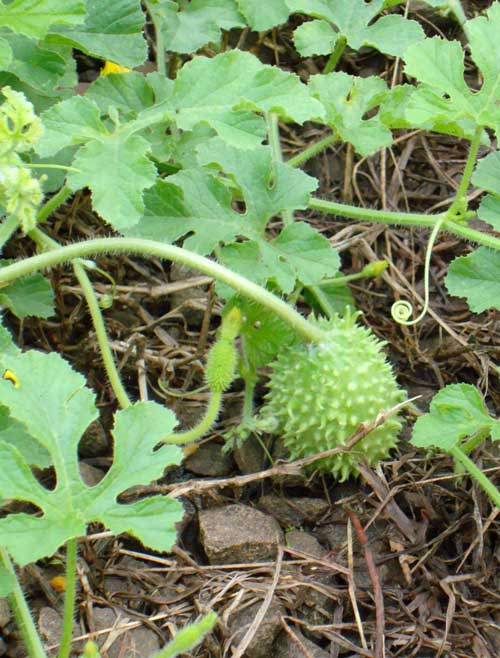
Cucumis anguria (*)
Classification System: APG IV
Superregnum: Eukaryota
Regnum: Plantae
Cladus: Angiosperms
Cladus: Eudicots
Cladus: Core eudicots
Cladus: Rosids
Cladus: Eurosids I
Ordo: Cucurbitales
Familia: Cucurbitaceae
Tribus: Benincaseae
Genus: Cucumis
Subgenus: C. subg. Cucumis
Sectio: C. sect. Aculeatosi
Species: Cucumis anguria
Varietates: C. a. var. anguria – C. a. var. longaculeatus
Name
Cucumis anguria L., Sp. Pl. 2: 1011. 1753.
Synonyms
Heterotypic
Apodanthera scaberrima Brandegee, Univ. Calif. Publ. Bot. 10: 188. 1922.
Cucumis anguria var. longipes (Hook.f.) A.Meeuse, Blumea Suppl. 4: 200. 1958.
Cucumis anguria subsp. longipes (Hook.f.) Greb. in R.Mansfeld, Verz. Landwirtsch. Gärtn. Kulturpfl., ed. 2, 2: 916. 1986.
Cucumis angurioides M.Roem., Fam. Nat. Syn. Monogr. 2: 79. 1846.
Cucumis arada L. ex Naudin & F.Muell., Select Pl. French ed.: 230. 1887.
Cucumis cubensis Gand., Bull. Soc. Bot. France 65: 28. 1918.
Cucumis echinatus Moench, Meth. 654. 1794. nom. superfl..
Cucumis erinaceus Naudin ex C.Huber, Nursery Cat. (Charles Huber Bros. and Co.) 1864(Cat. Print.): 6. 1864.
Cucumis jamaicensis Gand., Bull. Soc. Bot. France 65: 28. 1918.
Cucumis longipes Hook.f. in D.Oliver & auct. suc. (eds.), Fl. Trop. Afr. 2: 547. 1871.
Cucumis macrocarpos Wender. ex Mart., Reise Bras. 1: 536. 1823.
Cucumis parviflorus Salisb., Prod. 157. 1796, nom. superfl.
Cucumis subhirsutus subsp. minor P.Browne, Civ. Nat. Hist. Jamaica (ed. 2): 353. 1789.
Homonyms
Cucumis anguria Forssk. = Cucumis prophetarum subsp. prophetarum
Distribution
Native distribution areas:
Continental: Africa
Regional: West-Central Tropical Africa
Zaïre
Regional: East Tropical Africa
Tanzania.
Regional: South Tropical Africa
Angola, Malawi, Mozambique, Zambia, Zimbabwe
Regional: Southern Africa
Botswana, Namibia, KwaZulu-Natal, Swaziland, Northern Provinces
Source(s) of checklist:
References: Brummitt, R.K. 2001. TDWG – World Geographical Scheme for Recording Plant Distributions, 2nd Edition
References
Primary references
Linnaeus, C. 1753. Species Plantarum. Tomus II: 1011. Reference page.
Links
Hassler, M. 2019. Cucumis anguria. World Plants: Synonymic Checklists of the Vascular Plants of the World In: Roskovh, Y., Abucay, L., Orrell, T., Nicolson, D., Bailly, N., Kirk, P., Bourgoin, T., DeWalt, R.E., Decock, W., De Wever, A., Nieukerken, E. van, Zarucchi, J. & Penev, L., eds. 2019. Species 2000 & ITIS Catalogue of Life. Published online. Accessed: 2019 Dec 23. Reference page.
International Plant Names Index. 2019. Cucumis anguria. Published online. Accessed: Dec 23 2019.
Govaerts, R. et al. 2019. Cucumis anguria in Kew Science Plants of the World online. The Board of Trustees of the Royal Botanic Gardens, Kew. Published online. Accessed: 2019 Dec 23. Reference page.
Tropicos.org 2019. Cucumis anguria. Missouri Botanical Garden. Published online. Accessed: 23 Dec 2019.
USDA, ARS, Germplasm Resources Information Network. Cucumis anguria in the Germplasm Resources Information Network (GRIN), U.S. Department of Agriculture Agricultural Research Service. Accessed: 11 February 2009.
Vernacular names
English: Cackrey
português: Maxixe
svenska: Anguriagurka
中文: 西印度黄瓜
Cucumis anguria, commonly known as maroon cucumber,[3] West Indian gherkin,[4] maxixe,[5] burr gherkin,[6] cackrey,[7] and West Indian gourd,[3] is a vine that is indigenous to Africa, but has become naturalized in the New World, and is cultivated in many places.[2] It is similar and related to the common cucumber (C. sativus) and its cultivars are known as gherkins.
Description
Cucumis anguria is a thinly stemmed, herbaceous vine scrambling up to 3 meters long. Fruits (4–5 cm × 3–4 cm) grow on long stalks, and are ovoid to oblong. The fruits are covered with long hairs over a surface of spines or wart-like bumps. The inner flesh is pallid to green.[3]
Distribution
Although naturalized in many parts of the New World, Cucumis anguria is indigenous only to Africa, in the following countries: Angola; Botswana; the Democratic Republic of the Congo; Malawi; Mozambique; Namibia; South Africa (KwaZulu-Natal, Limpopo, Mpumalanga); Eswatini; Tanzania; Zambia; and Zimbabwe.[2]
Cucumis anguria has become naturalized in: Anguilla; Antigua and Barbuda; Australia (Queensland and Western Australia[8]); Barbados; Brazil; Cayman Islands; Costa Rica; Cuba; the Dominican Republic; Ecuador; French Guiana; Grenada; Guadeloupe; Guatemala; Haiti; Honduras; Jamaica; Madagascar; Martinique; Mexico; Netherlands Antilles; Nicaragua; Panama; Peru; Puerto Rico; Saint Lucia; Saint Vincent and Grenadines; Suriname; the United States (California, Florida, Georgia, Massachusetts, Montana, New York, Oregon, Texas, Minnesota, Wisconsin and Washington); Venezuela; and both British and American Virgin Islands.[2][4]
Cucumis anguria is also cultivated, but not indigenous to, nor yet believed to have become naturalized in these places: Cape Verde; Réunion; Senegal; and parts of the Caribbean not already mentioned above.[2]
Uses
Cucumis anguria is primarily grown (as a crop plant) for its edible fruit, which are used in pickling, as cooked vegetables,[3][9] or eaten raw.[3] The flavor is similar to that of the common cucumber.[10] C. anguria fruits are popular in the northeast and north of Brazil, where they are an ingredient in the local version of cozido (meat-and-vegetable stew).
Cucumis anguria has been used in folk medicine to treat ailments of the stomach.[11]
Pests
Crops are susceptible to attacks by fungi, aphids, and cucumber beetles.[3]
Synonyms
This species, Cucumis anguria L., has a name that other species may share:
Cucumis anguria Forssk., a synonym for Cucumis prophetarum
Retrieved from "http://en.wikipedia.org/"
All text is available under the terms of the GNU Free Documentation License

